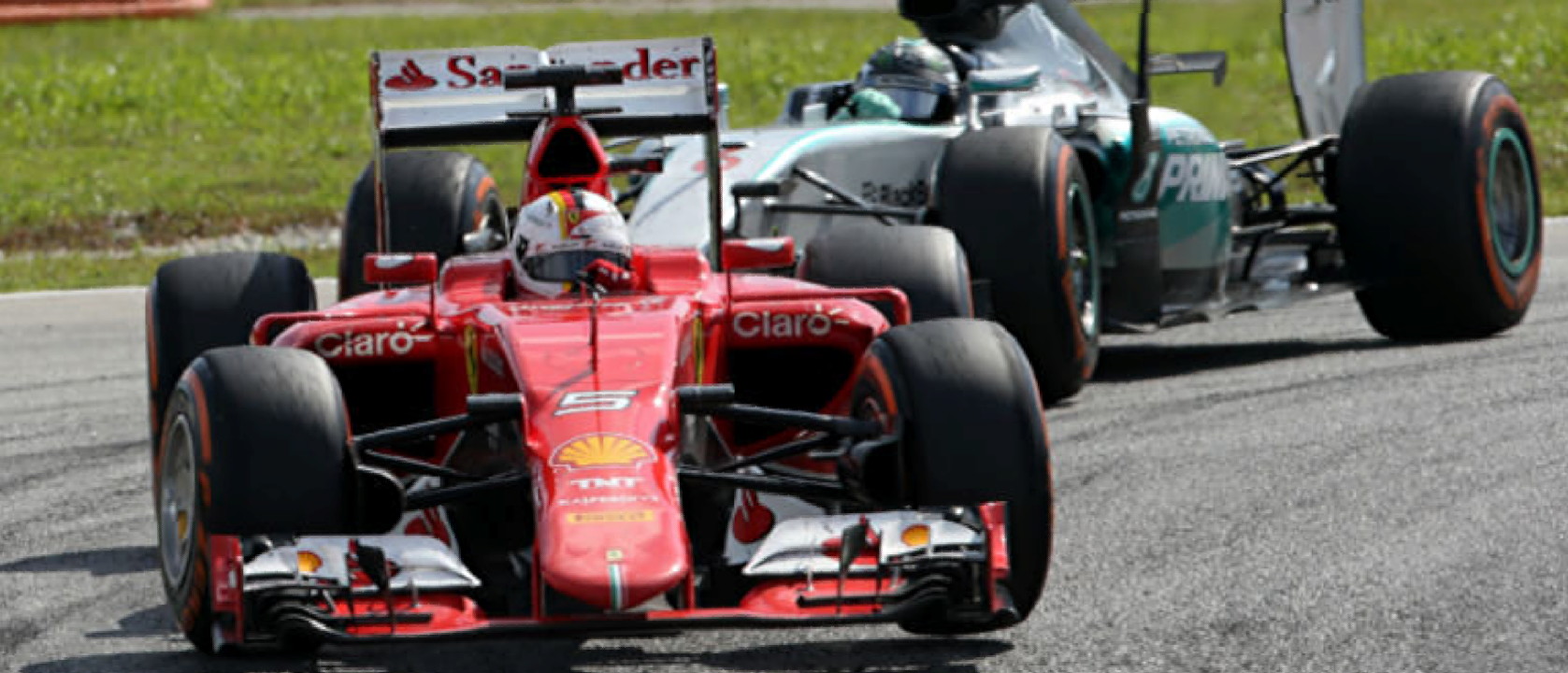After qualifying behind Lewis Hamilton in wet conditions at Sepang on Saturday, Sebastian Vettel thought victory in the 2015 Malaysian Grand Prix was possible, but suggested that more rain on race day was what he and Ferrari really needed. As it was, the win came in baking hot conditions. So how did he manage it and what does it mean?
Confusion and a serious strategy error cost Mercedes’ Lewis Hamilton a shot at winning the race, giving Ferrari’s Vettel the opening he needed — together with surprisingly quick race-trim pace and a new SF15-T car that seems far easier on its tires than the Mercedes W06 — to capture a remarkable GP victory.
Lewis Hamilton rues strategy and ‘confusing’ radio at Malaysian GP | BBC Sport
After holding onto his lead from pole position and moving out to a healthy gap after just a few laps at Sepang International Circuit on Sunday, Hamilton looked certain to claim his second win of the season. However, following a Safety Car period on lap five sparked by Marcus Ericsson’s spin into the gravel, Mercedes switched to a three-stop strategy that left both of its drivers struggling throughout the race.
Incredible shot! @ScuderiaFerrari embrace Sebastian Vettel after picking up the team's first #F1 race win since 2013. pic.twitter.com/gLbm9Gmvd6
— Yas Marina Circuit (@ymcofficial) March 29, 2015
Towards the end of his third stint, Hamilton was bearing down on Vettel in first place, and had hoped to switch to medium tires for the final stint that would give him a large pace advantage over the German driver, who would by then be on harder, slower and more worn primes. That’s when things went bad.
“There was a bit of confusion in the car. That’s always not good. When people speak to you in the corner, that’s really hard. They’re shouting at you and you’re like ‘what the hell’s going on?’ and it’s easy to lose focus.”
— Lewis Hamilton —
Astonishingly, Hamilton was fitted with prime tires at his last spit top, prompting him to bark to his team over the radio: “This is the wrong tire man!”
Analysis: How Sebastian Vettel beat Mercedes in the #MalaysiaGP http://t.co/rbDu07MCQk pic.twitter.com/cLiljGovQn
— Sky Sports F1 (@SkySportsF1) March 29, 2015
The hole was dug in that initial Safety Car period. Mercedes evidently believed that the superior performance we’ve seen from the W06 thus far in 2015 would have made the difference over the duration of the 56-lap race. It was a fatal miscalculation. Mercedes’ executive director Paddy Lowe acknowledged the team’s decision to pit early and switch to primes cost Hamilton time he was just unable to make up. “The advantage this gave to Ferrari on their two-stop strategy, and the time we lost in traffic in the first laps after the Safety Car, left us with a gap to Sebastian that proved too much of a challenge for us to recover,” Lowe said. The lap charts prove it. By the time Hamilton had passed Sergio Perez, Carlos Sainz, Romain Grosjean and Nico Hulkenberg, Vettel’s lead was 10 seconds. That 10s gap was essentially the same as the ending margin of victory.
How Mercedes’ Safety Car strategy backfired | F1 Fanatic
The 2 stop #F1 tyre strategy for #MalaysiaGP closely matched with #Vettel & @ScuderiaFerrari winning strategy! pic.twitter.com/uXracwjewr
— Pirelli Motorsport (@pirellisport) March 29, 2015
But performance still played a major role. Ferrari had demonstrated superior long-run pace during Friday practice and although there was no direct comparison with Mercedes on the hard tire, it was clear that the Silver Arrows were burning up their option tires quicker than the Ferraris, hence Vettel’s two opening stints on the medium tire that set up Sunday’s win. In contrast, Hamilton could be heard complaining that his hard tires weren’t lasting and later pulled out of his third stint — on medium-compound options — after just 14 laps. Vettel’s first stint with options, in contrast, was significantly longer at 18 laps.
Mercedes chief Toto Wolff admits Sebastian Vettel's #MalaysianGP win was a "wake-up call". #F1 http://t.co/WvYrK9qtkm pic.twitter.com/oOF3LMQ0l5
— AUTOSPORT (@autosport) March 30, 2015
Ferrari technical director James Allison confirms that tire wear was a significant factor in the win. “Our tires worked well on Friday. It gave us the confidence to know we could go deep into the race on that first stint. So we didn’t have to make that early stop. That allowed us a relatively easy passage past them.”
According to Sky Sports F1’s Martin Brundle, an indication came at the start of Saturday qualifying. “When Mercedes went out on the medium compound in Q1 it pretty much showed their hand that they were going to three-stop and that they preferred the hard compound tire,” he said. “I think at that point Ferrari thought ‘hang on, we have a great chance here.’”
Five questions to ask after Sebastian Vettel’s Malaysia GP win | Sky Sports F1 News
Of course, Seb’s skills had a lot to do with that. If the ultimate measure of a driver’s performance is his teammate, Vettel has cause to be grateful for the presence of Kimi Räikkönen, who had seemed just as strong as the weekend got underway but ultimately proved luckless. It’s an attribute all great champions need and although it’s still the early days of this new F1 season, the feeling already is that the change has done Sebastian good, something has clicked and Vettel has found his mojo again!



